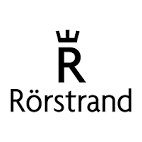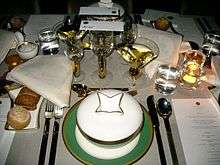Rörstrand
 | |
| Industry | Ceramic tableware and artware |
|---|---|
| Founded | 1726 |
| Parent | Fiskars |
| Website | http://www.rorstrand.com/ |
Rörstrand porcelain was one of the most famous Swedish porcelain manufacturers, with production initially at Karlberg Sea on Kungsholmen in Stockholm.
History






Rörstrand has been documented as early as the 13th century, when Magnus Ladulås donated property to the Clara Convent. In 1527, under Gustavus Vasa, the area was returned to the crown. The area was named "Rörstrand" because the clear lake's shore was overgrown with reeds.
After an ”Associations contract between all concerned in the Swedish Porcelain works, which will be established at great Rörstrand in the Delft manner” was signed in 1726, a porcelain factory was built at the castle Rörstrand.[1] The factory had indeed been privileged to produce true porcelain, but faience was the only thing that came to be produced until the 1770s. In 1758, rival Marieberg began to produce flintware. High production costs, small market, and strong competition from imported Chinese porcelain, kept Rörstrand from trying to copy Marieberg's goods.
By the 1770s, Rörstrand begins its own production of the English flintware, however, it takes time before Rörstrand succeed in developing its own technology in the new technique. After Marieberg was acquired in 1785, Rörstrand was the only major Swedish porcelain factory and the technology was not a priority. Only after Gustafsberg is founded in 1825 does mass production of printed tableware in earthenware take off. During the 1860s, Rörstrand porcelain was one of the nation's largest industries.
In 1900, there were around 1,100 employees. The factory's products had a worldwide reputation and participated successfully in various fields of art and industrial exhibitions. The expansion of the city meant that the land was needed for housing. The factory in Rörstrand was closed and demolished in 1926. Production was moved first to Gothenburg after acquiring the Gothenburg porcelain factory, and later to Lidköping in the 1930s.
Between 1960-1990, Rörstrand passed through several owners, including Upsala-Ekeby AB, Finnish Wärtsilä, Hakusan and Gustavsberg porcelain factory. As of 2001, Rörstrand is a part of Iittala, which, because of losses, moved production to Sri Lanka and Hungary. On 30 December 2005 the factory in Lidköping closed, and thus ended a nearly 280-year-old Swedish industrial history. In 2007 Iittala, which included the Rörstrand brand, was bought by Fiskars.
The former porcelain factory is now a museum, in which the legacy lives on.
Tableware
During the early years it was possible to order larger table sets in the same spot, but most were ordering goods and some named tableware was not.
When the printed decors for mass production turn up - the first dinnerware dates from 1826 - all without the name. In the mid-1800s, they started in price list are few illustrative names as "Turkish pattern" but only at the end of the 1800s created real name in tableware. The exception is the well-Willow, but its name and reputation already in England - Rörstrand made a variant of the decor around 1830-1888.
Purple lace pattern was one of the 1800s most popular tableware and manufactured well into the 1900s (about 1845-1934). At the turn of the century created a range of tableware which then remains in the range of nearly 50 years as Bella, Vineta.
Another of Rörstrands long-running dinnerware was "Green Anna" (as in an earlier version called Green Anna). Until 1926, however, made it to Gothenburg porcelain. The purple lace pattern produced from about 1845 and forward to 1934 also had a very long run. Ostindia is an example of one of the factory's popular designs, that is still produced today.
Some important products
- Since the 1760s leading manufacturers of stoves
- 1760's first printed decors
- 1770's first pieces of earthenware
- 1881 first dinner service of feldspar porcelain
- 1930 presentation of the National tableware, designed by Louise Adelborg, the Stockholm Exhibition of 1930
- 1991 presentation of the Nobel tableware, used since the Nobel Banquet
List of some designers and potters at Rörstrand
- Henrik Allert
- Hertha Bengtson
- Anna Boberg
- Ferdinand Boberg
- Anna Carlgren
- Drejargruppen
- Ossian Elgström
- Einar Forseth
- Isaac Grünewald
- Edward Hald
- Hertha Hillfon
- Ulrica Hydman-Vallien
- Filippa Knutsson (Filippa K)
- Sylvia Leuchovius
- Gertrud Lönegren-Jerkman
- Tyra Lundgren
- Jackie Lynd
- Gösta Millberg
- Gunnar Nylund
- Hilma Persson-Hjelm
- Signe Persson-Melin
- Carl-Harry Stalhane
- Pia Törnell
- Bertil Vallien
- Vicken von Post Totten
- Philip von Schantz
- Christian von Sydow
- Alf Wallander
- Marianne Westman
- Gun von Wittrock
See also
References
Citations
Sources
- Ankarberg, Carl-Henrik; Nystrom, Bengt: Rörstrand in Stockholm: brick, ceramic fajansmanufaktur and major industry 1270-1926, Stockholmia, Stockholm 2007, Monographs issued by the City, 0282-5899; 184 (Swedish). ISBN 978-91-7031 - 184-0 (inb.). Libris 10,468,157
- Bæckström, Arvid: Employment and disciplinary conditions in Rörstrands porcelain factory during the 1700s, the Museum of Technology, Stockholm 1934 (Swedish). Libris 10,353,271.
- Bæckström, Arvid: A so-called Cadogan-pitcher from Rörstrands childhood, Gothenburg 1951 (Swedish). Libris 10,553,574
- Bæckström, Arvid: Some ceramic messages: one more Cadogan-pitcher, Gothenburg 1953 (Swedish). Libris 10,553,585
- Candr'eus, Cecilia: "... new materials and manageable products ...": of Gustavsberg Fabriker manufacture of household plastics 1945-1970, Department of Art History University of Uppsala, Uppsala, 1998 (Swedish). Libris 10,145,021
- Eriksson, Gunilla: Flint Porcelain with printed decoration, Kulturen, Lund 1969 (Swedish). Libris 10,556,682
- Folcker, Eric G.: The oldest Rörstrandsfajanserna, 1910-1925 (Swedish). Libris 10,556,740 .
- Herlitz Gezelius, Ann Marie: Rörstrand, Signum, Lund 1989, Books on Art (Signum), 99-0345976-9 (Swedish). ISBN 91-85330-91-4 (inb.). Libris 7748022
- Jarefjäll, Katali; Quirin Bertil: Rörstrand: people, objects, plant, Bertil Quirin, [center] 2006 (Swedish). ISBN 91-972714-2-X (inb.). Libris 10,283,218
- Johansson, G.: Rörstrand: from manufacture to modern large-scale industry, 1726–1944, Malmo 1944 (Swedish). Libris 9820376
- Lagercrantz, Bo: Iris, Vineta and Green Anna Rörstrands Tableware 1860-1960, ICA, Västerås 1962 (Swedish). Libris 8873368
- The new Rörstrand. [Sweden] 1951 (Swedish). Libris 11,356,427
- Lagercrantz Stay: Rörstrand: decors 1850-1990, Rörstrands museum, [Lidköping 1990 (Swedish). Libris 1235293
- Nystrom, Bengt; Brunius Jan: Rörstrand 280 years: the faience, earthenware, porcelain & stoneware, Ica, Västerås 2007 (Swedish). ISBN 978-91-534-2785-8 (inb.). Libris 10,140,658
- Rörstrand Museum (Lidköping); Eklund Petter: Rörstrand Museum: everyday products and porslinsprimadonnor, Rörstrand Museum, Lidköping 2008 (Swedish). Libris 10,740,953
- Vogel Rödin Gosta: Rörstrand 250 years: the exhibition 17 June to 31 August 1976, Västergötland tourist association, Skövde 1976 (Swedish). Libris 1,320,085
- Gyllensvärd Bo, Hernmarck Carl: Rörstrand during three centuries: 1726-1943: Exhibition April 3 to May 16, 1943, *Nationalmuseum, Stockholm 1943, the National Museum exhibition catalog, 0585-3222, 91 (Swedish). Libris 1,411,525
- Rörstrands porcelain factory., Strengnas printed to Carl Erik Ekmarck. 1831 (Swedish). Libris 10,197,300
- Rörstrand Decors., Hackman Rörstrand, Lidköping 1996 (Swedish). Libris 2233424 .
- Scherman, Susanna, 1964 -; Perlmutter, Michael: The Swedish stove: 1700s production from Marieberg and Rörstrand, *Wahlström & Widstrand, Stockholm 2007 (Swedish). ISBN 978-91-46-21687-2 (inb.). Libris 10,415,873
- Ray, Gustaf Holdo: Rörstrand and Marieberg: a contribution to the Swedish ceramics history of UTI 18th century., The author., Stockholm 1870 (Swedish). Libris 1585292
- Ray, Gustaf Holdo: Rörstrands history and the effects of 1726-1850., Stockholm 1879, Rörstrands collection of earthenware and porcelain, a (Swedish). Libris 1610727
- Terrine from then and now: Rörstrand United States 260 years, 1986 (Swedish). Libris 3264927
External links
- Rörstrands Porcelain
- Rörstrand Museum in Lidköping
- Porcelain factory in Lidköping
- Article about Rörstrand
- Rörstrand - Technical Museum